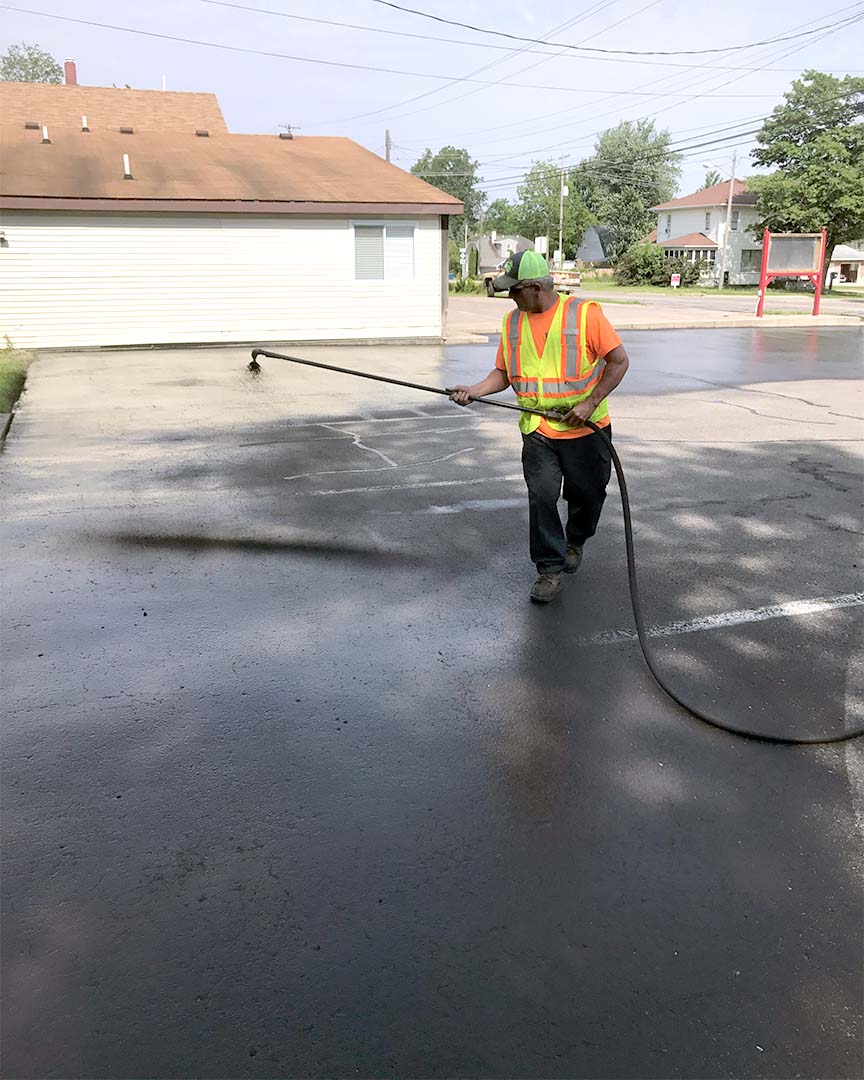Grasping Tilted Parking: How Asphalt Sealing Boosts Business Lots
Grasping Tilted Parking: How Asphalt Sealing Boosts Business Lots
Blog Article
Hot Mix Asphalt: A Lasting Option for Sidewalk
Hot Mix Asphalt (HMA) has emerged as a leading sustainable choice for pavement solutions, offering a myriad of cutting-edge modern technologies and ecological benefits. Its ability to recycle products and lower energy intake offers an engaging situation for its adoption in roadway building and construction jobs. Furthermore, the long-term efficiency and longevity of HMA make it a recommended choice for infrastructure development. As the demand for environmentally friendly construction techniques grows, exploring the subtleties of HMA's sustainability can supply beneficial understandings into the future of sidewalk options.
Ecological Benefits of Hot Mix Asphalt

Furthermore, Warm Mix Asphalt helps to alleviate urban warm island effects. Its dark color soaks up sunlight, lowering the amount of warmth reflected back right into the ambience compared to lighter-colored sidewalks. This can decrease ambient temperatures in metropolitan areas, reducing the need for air conditioning and eventually lowering energy usage.
In addition, Hot Mix Asphalt adds to boosted stormwater monitoring. Its permeable nature allows water to charge and penetrate the sidewalk groundwater products, lowering drainage and the risk of flooding. These environmental benefits make Hot Mix Asphalt a sustainable choice for paving highways and roads.
Energy Efficiency in HMA Production
Is energy efficiency an essential variable in the production of Hot Mix Asphalt (HMA)? Power plays a substantial function in the production of HMA, impacting both price and environmental sustainability. One key facet of energy efficiency in HMA manufacturing is the use of cozy mix asphalt (WMA) innovations.
Additionally, innovations in plant technologies have led to even more energy-efficient HMA production processes. By enhancing energy use in HMA manufacturing, the market can decrease its carbon impact while maintaining top notch pavement materials.
Recyclability of Hot Mix Asphalt
The recyclability of Warm Mix Asphalt (HMA) is a pivotal aspect of its sustainability and long-lasting ecological influence. HMA is one of the most recycled products in the USA, with over 100 million lots of recovered asphalt sidewalk (RAP) being recycled each year in new pavement building. Reusing HMA supplies numerous environmental benefits, such as decreasing the requirement for virgin products, decreasing power intake during production, and reducing the quantity of waste sent to landfills.
The process of recycling HMA includes grating the existing pavement, crushing it into smaller pieces, and mixing it with new aggregate and asphalt binder to browse around this web-site develop a recycled mix. This recycled mix can often carry out in addition to or even much better than traditional HMA, while needing fewer raw materials and producing lower greenhouse gas emissions. By including RAP right into brand-new sidewalk jobs, road agencies can preserve all-natural sources, minimize expenses, and reduce the environmental footprint of roadway building and construction and upkeep activities. In general, the recyclability of HMA plays a considerable role in promoting lasting methods within the pavement industry.

Long-Term Performance of HMA
Asphalt pavements demonstrate durability and durability over an extensive period, mirroring the long-lasting efficiency of Warm Mix Asphalt (HMA) In addition, developments in HMA technology, such as the use of polymer-modified binders and cozy mix asphalt, have further boosted the sturdiness and longevity of HMA sidewalks. By prioritizing high quality building and construction and maintenance methods, HMA proceeds to prove itself as a sustainable and cost-efficient option for long-lasting pavement facilities.

HMA: Longevity and Sustainability
Showing both resilience and sustainability, Warm Mix Asphalt (HMA) has come to be a foundation in the building and construction of lasting sidewalk facilities - commercial parking lot paving. HMA's toughness stems from its capacity to hold up against heavy lots, severe climate conditions, and high web traffic quantities, making it a reputable selection for streets, freeways, and airport runways. The make-up of HMA, which generally consists of accumulations, binder, and filler, plays an important duty in enhancing its durability and resistance to damage
Furthermore, HMA's sustainability depends on its recyclability and energy-efficient manufacturing process. The capability to recycle redeemed asphalt pavement (RAP) in new HMA mixes lowers the demand for virgin materials and lessens the ecological influence of pavement building and upkeep. In addition, the power efficiency of creating HMA exists in its recommended you read reduced blending temperatures contrasted to various other pavement materials, causing lowered power consumption and greenhouse gas emissions.
Conclusion
Finally, hot mix asphalt (HMA) provides a sustainable option for pavement with its eco-friendly qualities. HMA's recyclability, energy efficiency in manufacturing, and lasting durability make it an environmentally friendly choice for road construction. By conserving all-natural sources, minimizing waste, and reducing greenhouse gas discharges, HMA plays an important function in promoting sustainability in infrastructure growth. Its capacity to alleviate metropolitan heat island effects better emphasizes its value in producing ecologically conscious and resilient sidewalk systems.
HMA is one of the most recycled materials in the United States, with over 100 million tons of redeemed asphalt pavement (RAP) being recycled yearly in brand-new pavement construction.The procedure of recycling HMA includes milling the existing sidewalk, crushing it right into smaller pieces, and blending it with new accumulation and asphalt binder to create a recycled mix.Asphalt sidewalks demonstrate toughness and resilience check my blog over an extensive period, showing the long-term performance of Warm Mix Asphalt (HMA) Additionally, improvements in HMA technology, such as the usage of polymer-modified binders and cozy mix asphalt, have additionally enhanced the sturdiness and long life of HMA pavements. The capability to recycle reclaimed asphalt sidewalk (RAP) in brand-new HMA mixtures minimizes the need for virgin materials and reduces the ecological influence of pavement building and upkeep.
Report this page